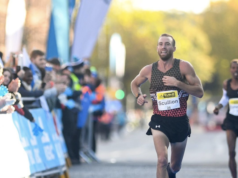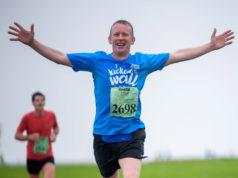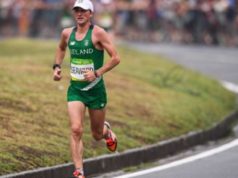

Tina Ryan, freelance journalist Tina Ryan meets Sonia O’Sullivan – Ireland’s middle distance runner and most crowned sportswoman
The track and field athlete Sonia O’Sullivan is Ireland’s most crowned sportswoman. Her illustrious career in middle-distance disciplines spanned the 1990s and culminated with an Olympic silver medal in the 5,000m in Sydney. Along the way, her trophy cabinet amassed titles from the World Athletics Championships (1995), the European Championships (1994 and double gold in 1998, double silver in 1992), the World Cross-Country Championships (double gold in 1998) and the World Indoor Championships (gold in 1997). Early on in her international career, Sonia chose to live in the suburbs of south west London, where the royal parks and river paths make an ideal training base and thus the British sports media embraced her as one of their own. Sonia, her two daughters and Australian partner Nic Bideau now share their time between London and Melbourne, Australia. I caught up with her just before she switched hemispheres.
When and how did you first get involved in athletics?
When I went to secondary school, there was an athletics club, Ballymore- Cobh, based just next to my school. When I was about 12, some friends and I realised that if you belonged to the club, you got to go away on weekends. We thought that sounded exciting, so we joined for the trips away.
When did you realise that you were talented?
I started out at the 100m and the long jump but I was terrible at both – I always came last at the 100m. Then, at the end of the first track season, I ran a cross-country race and won. Our squad also won that event too – I found the team element really appealing, which seems ironic now, as athletics is such an individual sport.
Was there any particular teacher who encouraged or even inspired you at school?
I was always encouraged by my PE teacher who liked me because I was good at sport, so he often singled
me out to demonstrate things. I found that quite embarrassing as my friends used to make fun of it. Our woodwork teacher Mr Hennessey loved sport and used to take us away to competitions. I think he knew I was talentedbefore I knew myself and was keen to encourage me. At every schools competition, my rival, Anita Philpott, would beat me. Then one day, when we were travelling to a race, Mr Hennessey said that he knew I’d beat her this time. I suppose I believed him because he was a teacher, so I beat her. And from that day she never beat me again. (Editor’s note: Anita Philpott became an internationally ranked athlete during the same era as Sonia O’Sullivan.) I’m still in contact with Mr Hennessey, who is in his seventies now. I visited him in hospital a few years ago. Shortly afterwards, I ran the Dublin women’s 10k. The route went past the hospital, so he had insisted on being wheeled outside to watch me. We waved at each other as I ran past – it was an extraordinary moment.
Did you believe from those early days that you could make it to the top of athletics?
No – but without really thinking about any fixed goals I realised I needed a training schedule. That was probably the first important step I took. I’d heard of a coach, Sean Kennedy, who was well known for his punishing programmes, so I called him. He used to write me a programme every two weeks and drop it through my letterbox – it was during that time that I thought I could be good. Later on, I got a sports scholarship to Villanova University in the USA. My running dropped off for the first two years as I was just growing up and I was getting used to all the changes in my life. In the last two years at college, I’d had the time to mature and refocus and that’s when I decided that I wanted to commit everything to athletics.
Did you ever lose your selfbelief during your career?
There are often moments of self-doubt for athletes, mainly when you don’t run so well but also after time off from training. At the start of every season, it’s a bit like beginning all over again – you never really know what you are worth. It’s important to have people around you – your coach, manager and physiotherapist – who continue to believe in you and support you during those uncertain times.
Do you think that sporting role models are important and did they play any part in your own success?
I am personally motivated by seeing ‘normal’ people I know achieving great things. I find it harder to take inspiration from ‘famous’ people who are intangible to me. Marcus O’Sullivan (no relation) and Frank O’Mara were two Irish International athletes when I was starting out. They were just normal people, very approachable and supportive. They made me realise that you didn’t have to be out of this world to be great, so I believed that success was within my capability too.
The fascinating thing about top sportspeople from a spectator’s point of view is their ability to pick themselves up after periods of disappointment, injury or other form of adversity and go on to succeed. What do you put this ability down to?
I think that it’s about being convinced of your goals. When things go wrong, you always find yourself at a crossroads with arrows pointing in different directions and some paths are easier than others. Sometimes you even veer off your course but ultimately the belief comes back and you move forward, putting all your efforts and emotions into it.
The other powerful appeal of sport is that it reveals the emotional effect winning and losing has on athletes. Does that make you feel vulnerable?
It never made me feel vulnerable before a race. You only have that feeling of being exposed if things go wrong. At the end of a bad race, you know you will have to justify what you have done immediately after crossing the line but you often don’t have the answers yourself then. At that point, the stadium feels like a cauldron and you are trapped in it. All you really want to do is go away and have some time to think it through with the people closest to you.
What was your greatest sporting moment?
Winning my Olympic silver medal in Sydney. Athletes’ careers are defined in Olympic terms and this was like a final stamp of approval for everything I had achieved.
And your biggest setback?
Losing out on a medal in 1996. I was the most convincing contender for the Olympic title, having been invincible in the run-up to the Atlanta Olympics. Losing was simply unacceptable to everyone. It took a long time to put that behind me. Winning an Olympic silver medal seems to spark different emotional reactions in top athletes. It can be the best moment ever for some and a huge disappointment for others.
Although you consider Sydney to be your greatest sporting moment, was there a part of you that felt frustrated with your silver?
If I had known before the race how close it was going to be, then I definitely would have won. I don’t think that I was expected to win, in fact, I had fallen right back in the race but was given a second chance. I realised it and told myself that it was all or nothing. When Szabo (the Romanian Gabriella Szabo) beat me to the line, my coach said that he sensed my disappointment as I lowered my head. I was taking a few seconds to take stock of what had happened then I looked up and smiled and he knew that at that moment that I had reconciled my feelings and could be happy with what I had achieved.
You won your Olympic silver medal when your eldest daughter was a year old – quite a remarkable achievement. How did you manage firstly, to get back into shape, then, juggle motherhood and training and finally, stay focused on your ultimate goal – the Olympics?
Obviously, in fitness terms, being pregnant was new territory for me. I did a lot of research to ensure I knew what I was doing. I wanted to be as fit as possible without taking any risks. I certainly did not want to stop training completely as the risk of injury is much higher when you start again from nothing. During the pregnancy, I had possibly even gained in terms of endurance as it’s a bit like running in altitude. When Ciara was born, I wanted to prove I could come back to the same level. In the beginning, it was the great unknown – I had a different body and couldn’t compare my training situation to other previous experiences but Ciara’s needs took my mind off any negativity and actually things were made easier by the fact that I got stronger at every session. Juggling the baby routine was more tricky, as the day is not your own anymore but I did a lot of training before she woke up and I had a lot of support from my partner, Nic.
What is the Irish public’s reaction to your victories? Do you ever see yourself living there again?
There are so many Irish living all over the world but I think most regard Ireland as home. Even though I don’t live there, I could only ever consider myself as Irish. At the beginning of my running career, it was a bit strange to be looked at in the street and I felt a little cautious. Now that I’m easing off running professionally, I’m freer to stop and chat with anyone in the street – most people are appreciative and want to talk about my racing. They even remember specific races better than me. And of course, it’s enjoyable because Irish people always know how to make you laugh.
What has your children’s reaction been to your running career?
They are still too young to really understand what it is all about (Ciara is eight years old and Sophie is six) but they find it amusing when people ask for my autograph. The funny thing is that when they see my
picture or something on TV, they say, “That’s Sonia O’Sullivan!” as though I were someone else. Ciara’s favourite athlete is Kelly Holmes. Recently, her dad told her: “Do you know, your mum used to regularly beat Kelly in races?” We had to show her TV footage to prove it.
Has having children affected your attitudes to school sport?
I’ve realised how important it is for schools to encourage children to participate, especially as some kids are not exposed to enthusiasm for sport and exercise at home. I obviously get more involved myself now, not just at my daughters’ school but in other schools too. For me, it’s not only about ‘giving something back’ to my sport – I enjoy watching the impact I can make on children, especially at primary school level.
So many athletes choose not to run competitively once their elite career is over, yet you seem to really enjoy it. What makes you want to continue lining up at the start after so many years as a professional athlete?
I wouldn’t feel healthy if I didn’t get some exercise every day. I go to the gym but I prefer to run outside – it seems like the most natural thing to do and, yes, I still enjoy it. I run in mass-participation races and I continue to set myself goals in the same way that all runners do. I also run for a local club, the Thames Hare and Hounds, with my training partner (and current top Australian 10,000m/Marathon runner) Benita Johnson. We enter lots of team events for fun really. We help raise the team’s overall score and that often spurs on the other team members.
What would you like to be doing in 10 years’ time?
The London Olympics will have come and gone by then and possibly changed the face of sport in this country. Of course, I would like to be involved in sport long term. At the moment, I’m particularly interested in motivating support professionals like coaches and physiotherapists to maximise their own potential. There’s still a lot to be done in terms of recreating in children that basic passion for sport and that drive to succeed. I would like to be more involved in that challenge in some way.
Tina Ryan is a freelance journalist
This article first appeared in PE & Sport Today – Dec 2007






